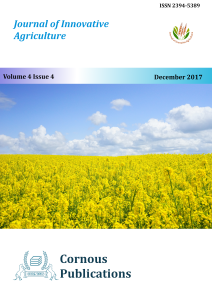
Journal of Innovative Agriculture
Peer Reviewed Open Access Journal
ISSN: 2394-5389 NAAS Rate: 4.05
Submit Manuscript
Peer Reviewed Open Access Journal
ISSN: 2394-5389 NAAS Rate: 4.05
Submit ManuscriptIntegrated weed management is a system approach where by whole land use planning is done in advance to minimise the very invasion of weeds in aggressive forms and give crop plants a strongly competitive advantage over the weeds. Further, importance is given to involve more than one method of weed control in tackling the weeds so those broad spectrums of weeds are kept under check for longer period. A pre emergence herbicide take care of weeds only for a limited period and do not give long term weed control in a long duration crop like cotton where the problem of late emerging weeds arises and escape killing. So to attain a season long weed control, integration of chemical, mechanical and cultural methods holds a great promise in crop production. Hence, integrated weed management in cotton play important role in increasing crop production. Field experiments were conducted during 2013 and 2014, at Agricultural College and Research Institute, Madurai (Tamil Nadu Agricultural University) to study the effect of integrated weed management in rainfed cotton. The weed management practices consisted of pendimethalin (1.0 kg.ha-1) and (Calotropis gigantea leaf extract spray at three concentrations (10%, 20%, and 30%) in combination with power weeder operation twice and manual weeding twice. From the results of the experiments, it could be recommended that the integrated weed management practices like, application of PE pendimethalin at 1.0 kg ha-1 + power weeding on 40 DAS (T11) recorded higher seed cotton yield and economic return.
Economic return, weed density, weed dry weight, yield
Ali, H., D. Muhammad and S.A. Abid. 2005. Weed control practices in cotton (Gossypium hisrsutum L.) planted in beds and furrow. Pak. J. Weed Sci. Res., 11(1-2): 43-48.
Balasubramanian, K., 1992. Studies on chemical and tillage method of weed control in cotton and residual effect of herbicides on succeeding crops. Ph.D. Thesis, Tamil Nadu Agricultural University, Coimbatore, India, p.110.
Brar, A.S., R.J.S. Thind and L.S.Brar. 1995. Integrated weed control in upland cotton (Gossypium hirsutum L.). Indian J. Weed Sci., 27(3&4): 138-143.
Brar, A.S., R.J.S. Thind and L.S.Brar. 1999. Integrated weed management in American cotton. J. Res. Punjab Agric. Univ., 36(3-4): 194-198.
Chander, S., S.K. Kahal and B.S.Panwar. 1994. Harayan J. Agron., 10(2): 237 - 239.
Das, T.K. and B.Duray. 1998. Pendimethalin, an excellent herbicide for weed control in crops. Intensive Agri., 36(5-6): 18-20.
Deshpande, R.M., W.S. Pawar, P.S. Mankar, P.N. Bobde and A.N. Chimote. 2006. Integrated weed management in rainfed cotton (Gossypium hirsutum L.). Indian J. Agron., 51(1): 68-69.
Gnanavel, I. and S. Babu. 2008. Integrated weed management in irrigated hybrid cotton. Agric. Sci. Digest, 28(2): 93-96.
Nair, P.K.R., J.P. Tiwari and N. Rahman. 1983. Weed control by herbicides in tomato. Indian J. Weed Sci., 15(1): 77-79.
Nalini, K. 2010. Evaluation of pre-emergence herbicide in winter irrigated cotton and its residual effect on succeeding crops. Ph.D. Thesis, Tamil Nadu Agricultural University, Coimbatore, India, p.102.
Nazar, R., S.Begum, A.Naz1, R. Qureshi, R. A. Memon, A. K. Chaudhry and Z. Akram. 2008. Weed flora of Pir Mehr Ali Shah Arid Agriculture University Rawalpindi. Pak. J. Weed Sci. Res., 14 (1-2): 55-72.
Panwar, R.S., R.K. Malik, R.S. Banga and O.P. Kataria. 1995. Effect of time of pendimethalin application on weed control in cotton. Haryana J. Agron., 13(1): 78-80.
Prabhu, M. 2010. Evaluation of integrated weed management practices in bt cotton. M.Sc., Thesis, Tamil Nadu Agricultural University, Coimbatore, Tamil Nadu, India, p.112.
Prakash,V., A.K. Pandey, P. Singh, S. Chandra, V.S. Chauhan and R.D. Singh.1999. Integrated weed management in tomato under north-western Himalaya. Crop Res., 17(3): 345-350.
Rajavel, M., N. Arunachalam, O.S. Kandasamy, S. Natarajan and K. Ramamoorthy.2002. Allelopathic effect of plant materials on weed growth and yield of irrigated cotton var. MCU 5 (Gossypium hirsutum L.). Madras Agric. J., 89 (4-6): 363-365.
Shaikh, M.A., A. Saleem and N.A. Malik.2006. Integrated weed management and its effect on the seed cotton yield in cotton crop. Pak. J. Weed Sci. Res., 12(1-2): 111-117.
Shobana, J. 2002. Studies on plant leachates, herbicide and manual weeding as weed management practices in maize based intercropping system. M.Sc., Thesis, Tamil Nadu Agricultural University, Coimbatore, India, p.92.
Sripunitha, A. 2009. Herbal hydration-dehydration treatments for improving vigour, viability and productivity in tomato (Lycopersicon esculentum.Mill) cv. PKM 1. M.Sc., Thesis, Tamil Nadu Agric. Univ., Coimbatore, Tamil Nadu, India.
Velayutham, A. 1996. Studies on the bio-efficacy of herbicides and their application techniques in cotton based intercropped systems. Ph.D. Thesis. Tamil Nadu Agricultural University, Coimbatore, India, p.99.
Vivek, S., S. Tripathi and B.P. Dhyani.2002. Integrated weed management in cotton in cotton-wheat system. Indian J. Weed Sci., 34(3&4): 243-246.
